Introduction and Package
Introduction of the GIGABYTE R9 280 WINDFORCE 3GB OC
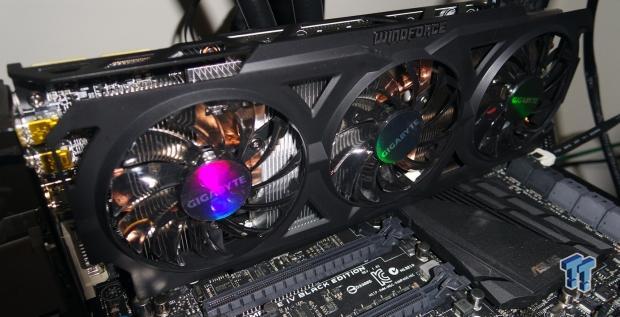
Earlier in the year, we saw AMD launch the R9 280, and we got a chance to look at the Sapphire version of the model. To say we left feeling unimpressed would be an understatement. The R9 280 was and is a rebadged HD 7950. That's not a bad thing. The HD 7950 was and is a great video card, but the price that AMD launched it at was just too high to be truly considered reasonable.
I said that the model was a misstep in what had been a near flawless launch of the R series of video cards. AMD had just chosen to launch the model at a price that wasn't reasonable and made no sense. Recently, AMD dropped the price on the model, and we feel that it now sits at a much better place. In an effort to fix the negative press that surrounded it initially, they're now making a push to have the model reexamined.
Today, we're looking at one of the three R9 280 3GB cards we have on hand. We'll be looking at them in a few different ways. The first one today comes from GIGABYTE and we'll simply be running it at the out of the box speeds to see just how the model performs these days with the latest drivers.
With the other two, we want to take the time to look at the overclocking performance of the model along with CrossFire performance by pairing up two of the cards. But, those two articles are for later. It's been a long time since we've had the chance to look at a GIGABYTE card, and if it wasn't for the fact that this particular one came from AMD, it would probably be even longer before we saw one.
Package - What comes inside the box
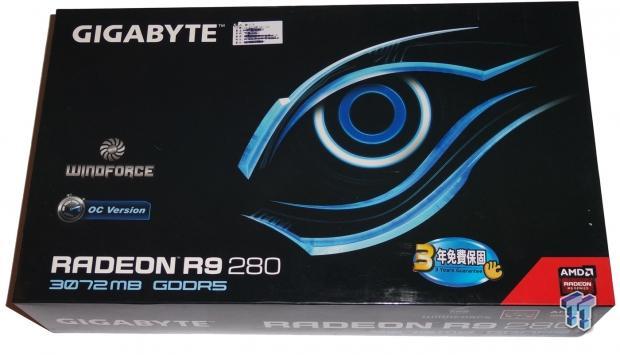
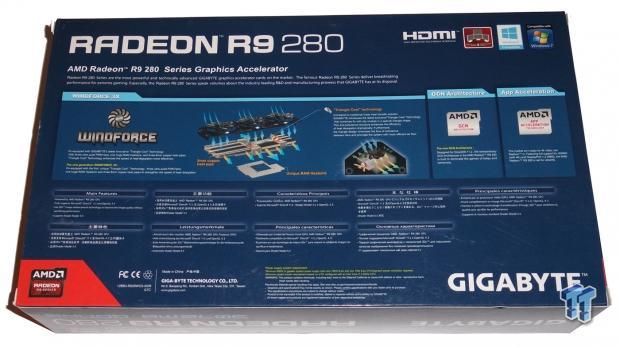
Taking a look at the front of the box, we have the GIGABYTE logo at the top, while across the bottom we have the model number. Towards the middle of the box, you can see that this is a WINDFORCE and OC Version of the R9 280. Flipping the box over, you can see that GIGABYTE goes into more detail on the WINDFORCE cooling solution, which uses a triple fan setup. We'll look at it all a bit closer on the next page when we check out the card.
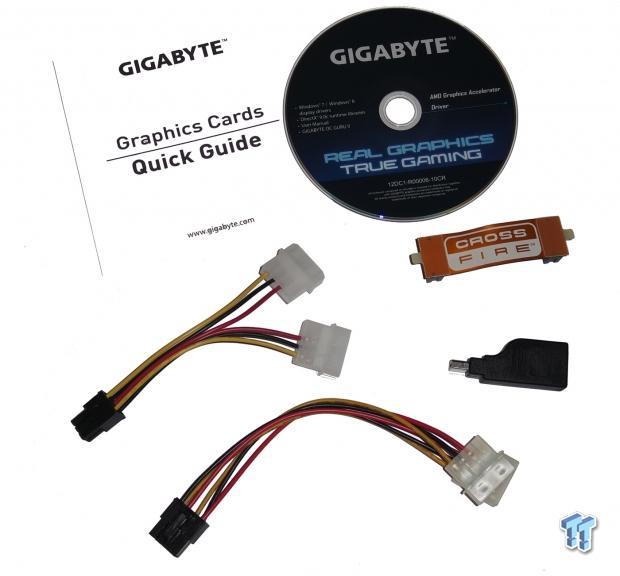
Opening the box and diving inside, you can see there's not too much going on with the bundle. You've got the usual suspects: a Quick Guide and Driver CD; two power connectors, with one being a Dual Molex to 6-Pin PCIe and the other a Dual Molex to 8-Pin PCIe one; a CrossFire connector; and a MiniDP to DisplayPort connector.
PRICING: You can find the GIGABYTE R9 280 WINDFORCE 3GB OC for sale below. The prices listed are valid at the time of writing but can change at any time. Click the link to see the very latest pricing for the best deal.
United States: The GIGABYTE R9 280 WINDFORCE 3GB OC retails for $232.99 at Amazon.
Canada: The GIGABYTE R9 280 WINDFORCE 3GB OC retails for CDN$368.67 at Amazon Canada.
Video Card Details and Specifications
Close up with the GIGABYTE R9 280 WINDFORCE 3GB OC
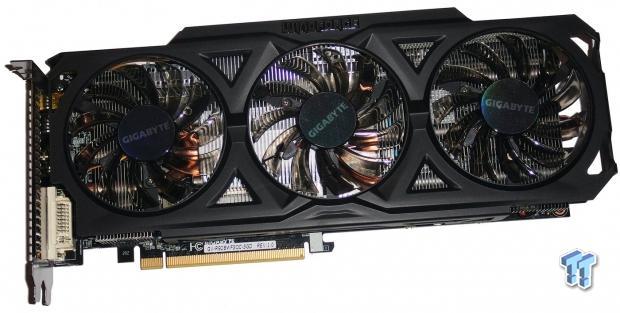
Taking a look at the card, you can see the massive WINDFORCE cooler pretty much takes the entire PCB, with just a little above the PCIe slot being seen. The massive triple fan setup looks great, and behind you can see the massive heat sink. Looking closer, you can see a number of copper heat pipes going throughout the card. The cooler looks like serious business and hopefully can do a good job today. We'll find out just how good it is a little later on.


Moving around the card, you can see at the back that we have a dual power connector setup, which sees a single 6-Pin PCIe and a single 8-Pin PCIe power connector. Staying across the top but moving closer to the front, you can see we have our two CrossFire connectors. While we won't be making use of them today, we will be testing out CrossFire on the R9 280 3GB in the coming weeks.

Heading over to the I/O side of things, you can see across the top that we have a large vent setup that will let the air escape out the back of the case. As for the connectivity side of things, you can see we have a single Dual-Link DVI-I connector along with an HDMI port and two MiniDP connectors. I'm a big fan of this kind of setup as it is heavy on the DisplayPort side.
What really stands out is the fact that GIGABYTE has chosen to include a MiniDP to DisplayPort connector in the bundle. It means that if you're on a DisplayPort monitor with a normal DP cable, you'll be able to use the DP connection straight away.
Specifications
Looking below, you can see the clock speeds on the GIGABYTE R9 280 WINDFORCE 3GB OC. We must say that they're quite healthy with a core clock of 1072 MHz. As for the 3GB of GDDR5 that is present on the card, that comes clocked in at a nice round 5000MHz QDR.
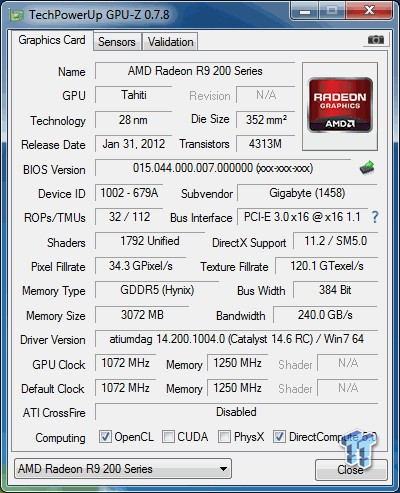
This is a really nice overclock that is much stronger then the Sapphire we looked at, which saw a core clock of just 940MHz. Both companies, with little surprise, left the memory at stock with the 5000MHz QDR number. With this clock, we're hoping performance looks a lot stronger than it did the last time we looked at the R9 280.
Test System Setup & FPS Numbers Explained
Test System Setup

We would like to thank the following companies for supplying and supporting us with our test system hardware and equipment: Intel, ASUS, and Corsair.
Taking a look at our graphs today, we have an absolute ton of cards included to see just how the GIGABYTE R9 280 WINDFORCE 3GB OC looks today. Sitting on each side of the R9 280, we have the HIS R9 270X IceQ X2 Turbo Boost 2GB OC below it and Sapphire R9 280X 3GB Vapor-X OC sitting above it.
Moving further north, we have the R9 290 4GB IceQ X2 Turbo, reference AMD R9 290X, and the recently looked at HIS R9 290X iPower IceQ X2 Turbo 4GB, which we overclocked to 1100MHz on the core and 5700MHz QDR on the memory.
Finally, we finish off our graphs with a couple of NVIDIA cards, including the reference GTX 770 2GB and the ASUS GTX 780 ROG Poseidon Platinum 3GB OC.
The FPS Numbers Explained
When we benchmark our video cards and look at the graphs, we aim to get to a certain level of FPS which we consider playable. While many may argue that the human eye can't see over 24 FPS or 30 FPS, any true gamer will tell you that as we climb higher in Frames Per Seconds (FPS), the overall gameplay feels smoother. There are three numbers we're looking out for when it comes to our benchmarks.
30 FPS - It's the minimum number we aim for when it comes to games. If you're not dropping below 30 FPS during games, you're going to have a nice and smooth gaming experience. The ideal situation is that even in a heavy fire fight, the minimum stays above 30 FPS making sure that you can continue to aim easily or turn the corner with no dramas.
60 FPS - It's the average we look for when we don't have a minimum coming at us. If we're getting an average of 60 FPS, we should have a minimum of 30 FPS or better and as mentioned above, it means we have some smooth game play happening.
120 FPS - The new number that we've been hunting down over recent months. If you're the owner of a 120 Hz monitor, to get the most out of it you want to get around the 120 FPS mark. Moving from 60 FPS / 60 Hz to 120 FPS / 120 Hz brings with it a certain fluidity that can't really be explained, but instead has to be experienced. Of course, if you're buying a 120 Hz monitor to take advantage of 3D, an average of 120 FPS in our benchmark means that in 3D you will have an average of 60 FPS, which again means you should expect some smooth gameplay.
Why are some graphs incomplete?
Adding new game benchmarks is a long, tedious and time consuming task as every video card has to be re-tested in those new benchmarks. Because of that reason we have always just evaluated our benchmark line up every six months. To stay up to date and current with the latest benchmarks and games available, we've changed our approach to adding new benchmarks.
Our benchmark line up will progress and be updated as newer more intensive games with benchmarks comes to light. While this will mean that initially you may only see a single video card in those particular graphs, as the weeks go on and we test more and more video cards, the results will grow quickly. This will help keep our benchmark line up as up to date as possible as we introduce and remove games on a constant basis.
Benchmarks - 3DMark
3DMark 11
Version and / or Patch Used: 1.1
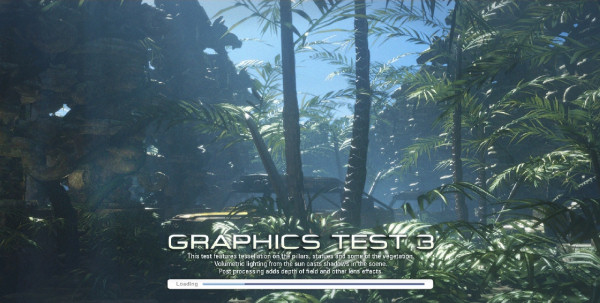
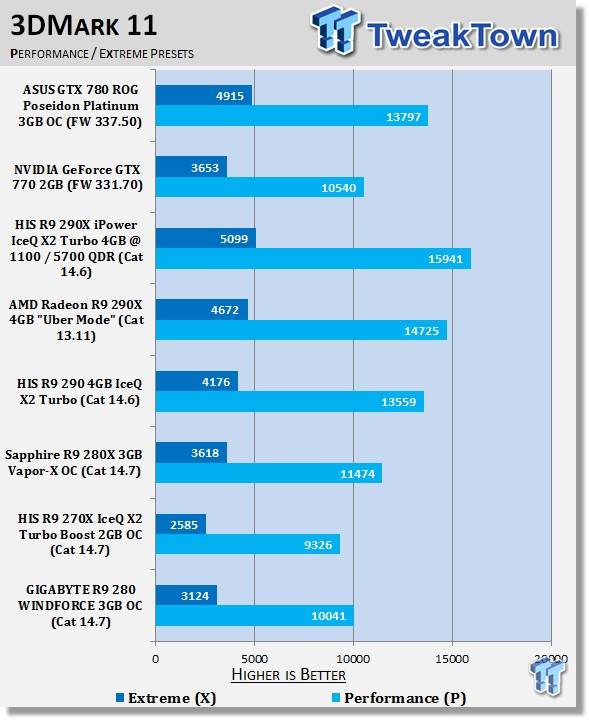
Coming out of the gate with 3DMark, we can see that the GIGABYTE R9 280 WINDFORCE 3GB OC sits quite nicely between the R9 270X and R9 280X we have here.
3DMark Fire Strike
Version and / or Patch Used: 1
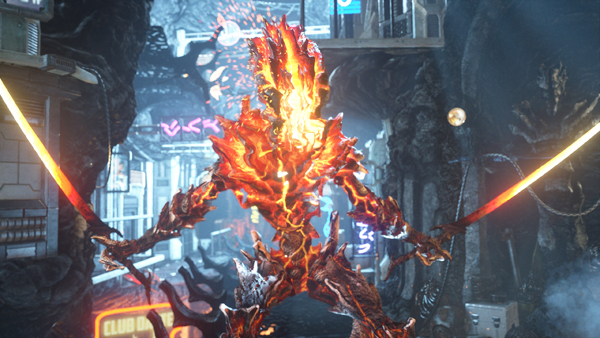
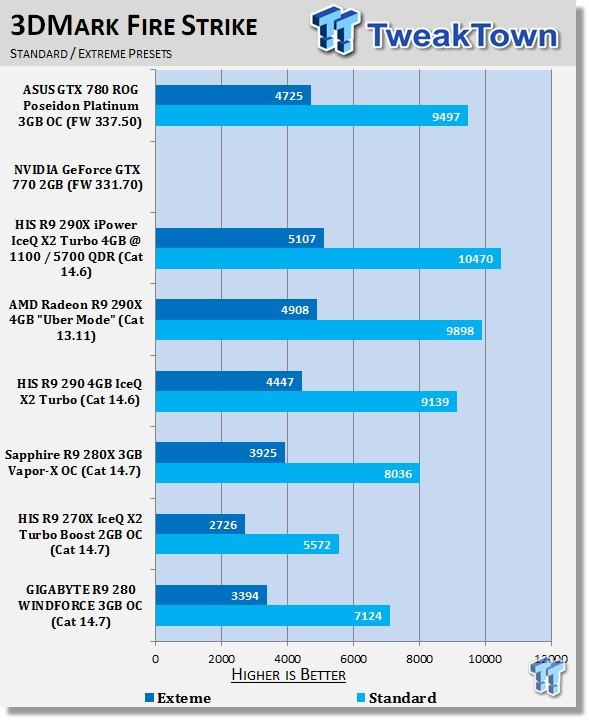
Fire Strike performance doesn't look bad, and you can see that performance gains over the R9 270X are quite strong. Here we can see that the GIGABYTE R9 280 WINDFORCE 3GB OC sits in quite a good position between the 270X and the R9 280X that sits above it.
Benchmarks - 3DMark Sky Diver & Catzilla
3DMark Sky Diver
Version and / or Patch Used: 1.1

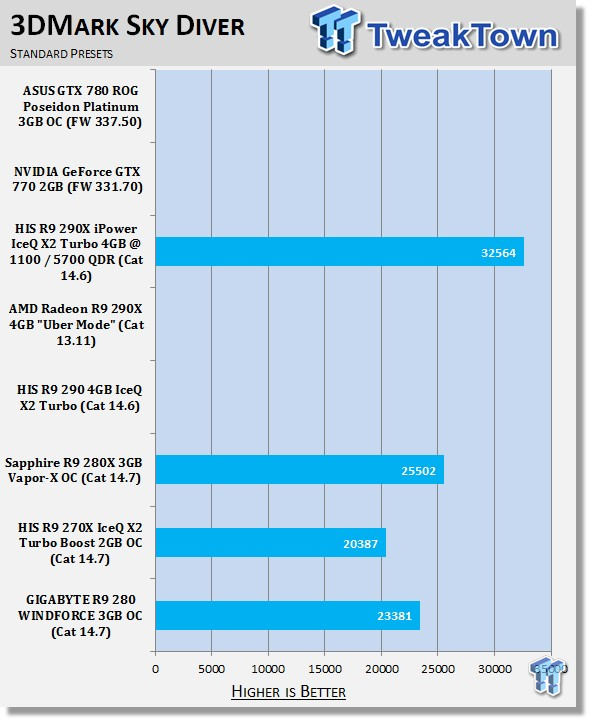
Sky Diver sees the GIGABYTE R9 280 WINDFORCE 3GB OC again sit in a good position between the two cards, favoring just a little towards the R9 280X.
Catzilla
Version and / or Patch Used: 1.3


Catzilla continues the trend, and the GIGABYTE R9 280 WINDFORCE 3GB OC sits in a good position between the R9 270X and R9 280X. Overall performance doesn't look bad, and we're looking forward to seeing how it goes when we move into our game testing in just a moment.
Benchmarks - Unigine Heaven & Phantasy Star Online 2
Unigine Heaven Benchmark
Version and / or Patch Used: 3
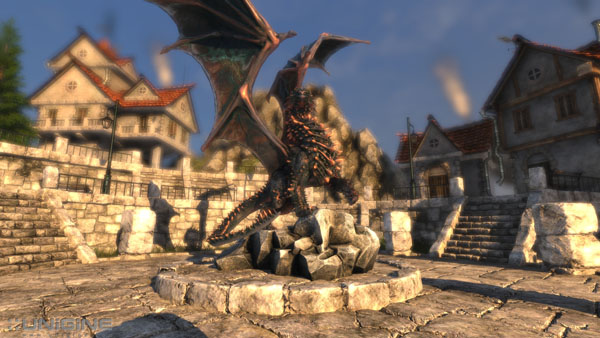
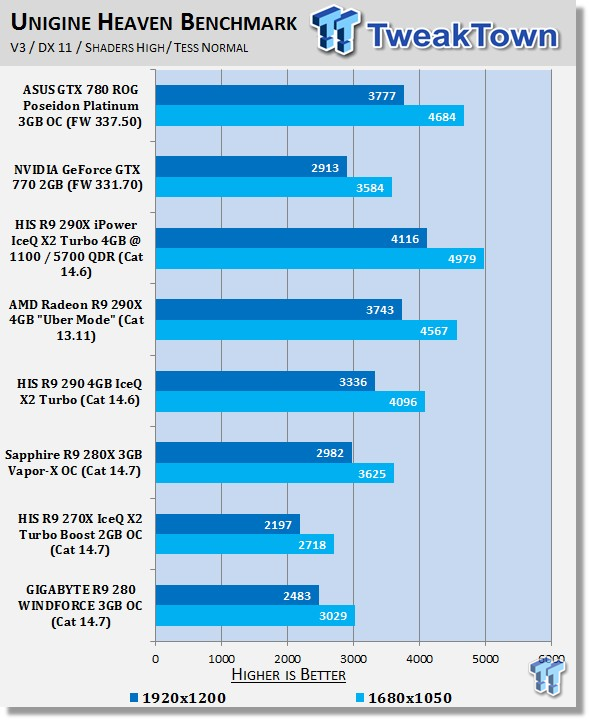
The GIGABYTE R9 280 WINDFORCE 3GB OC gets a nice little boost over the R9 280X in Heaven. Looking above, though, you can see that it leans more towards the R9 270X in this case. The R9 280X, on the other hand, performs around 20 percent faster at both resolutions.
Phantasy Star Online 2
Version and / or Patch Used: Standalone Benchmark


PSO 2 performance sees a score that sits on the lower side of things. This isn't a huge surprise considering we bench this particular game at 2560x1600. Moving down to 1680x1050 or 1920x1080 will see numbers that are more than enough.
Benchmarks - Lost Planet 2 & Just Cause 2
Lost Planet 2
Version and / or Patch Used: Standalone Benchmark
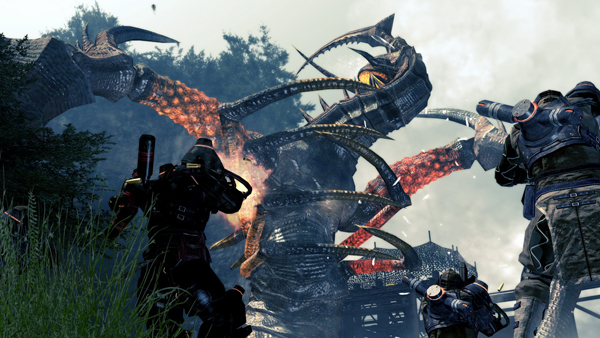

Lost Planet 2 numbers are solid across the board, and you can see that at the highest resolution we manage to achieve a solid 65 FPS average. This is the biggest difference between it and the R9 270X, which fails to offer playable FPS at the highest resolution.
Just Cause 2
Version and / or Patch Used: Latest Steam Update


Just Cause 2, just like Lost Planet 2, sees some great numbers across the board. At the highest resolution, we can see that the GIGABYTE R9 280 WINDFORCE 3GB OC manages to offer a strong 79 FPS average. In this instance, we can see that the R9 280 manages to sneak out a win against the GTX 770 2GB.
Benchmarks -Metro Last Light & Nexuiz
Metro Last Light
Version and / or Patch Used: Latest Steam Update


Looking at Metro Last Light, you can see that the GIGABYTE R9 280 WINDFORCE 3GB OC manages to get a nice little performance boost over the R9 270X. Looking above, you can unfortunately see that the card does continue to fall short of that playable 60 FPS we're on the hunt for at all resolutions.
With that said, though, you can see that at 1680x1060, the 58 FPS average is quite solid. A slight adjustment to detail will give a playable experience.
Nexuiz
Version and / or Patch Used: Latest Steam Update
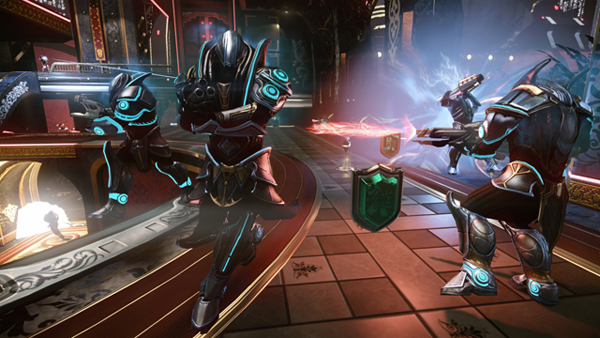
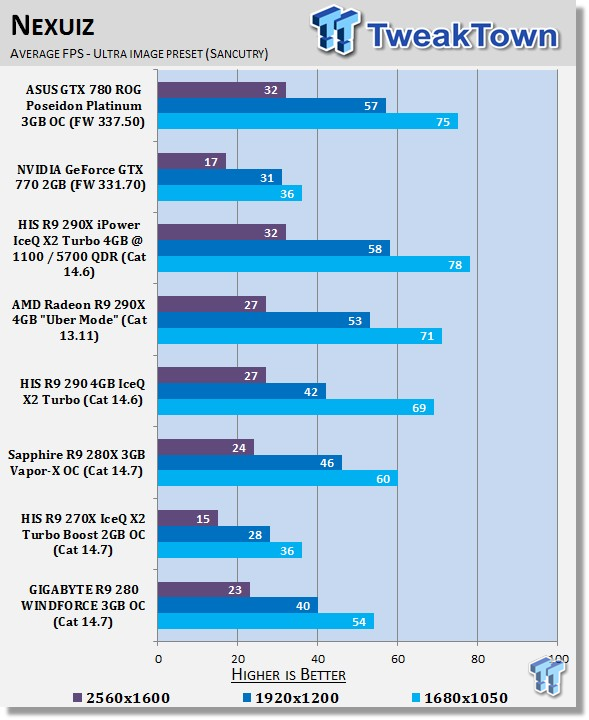
It comes as no surprise that Nexuiz performance across the board is just too low. The 54 FPS average at 1680x1050 isn't too bad, but it's still just short of that 60 FPS number we're always-on the hunt for. Saying that, if you wanted to drop the detail a bit, you could get a smooth gaming experience with no major issues.
Benchmarks - Sniper Elite V2 & Sleeping Dogs
Sniper Elite V2
Version and / or Patch Used: Standalone Benchmark
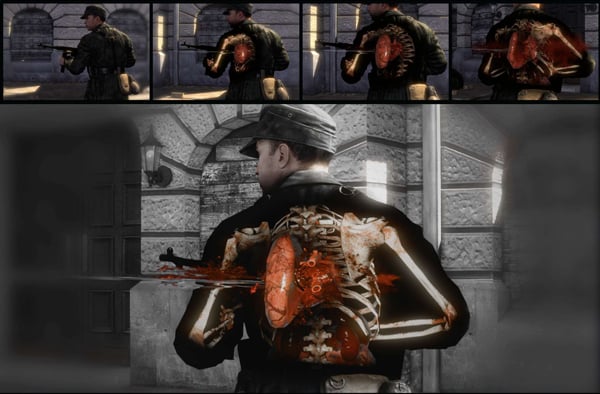
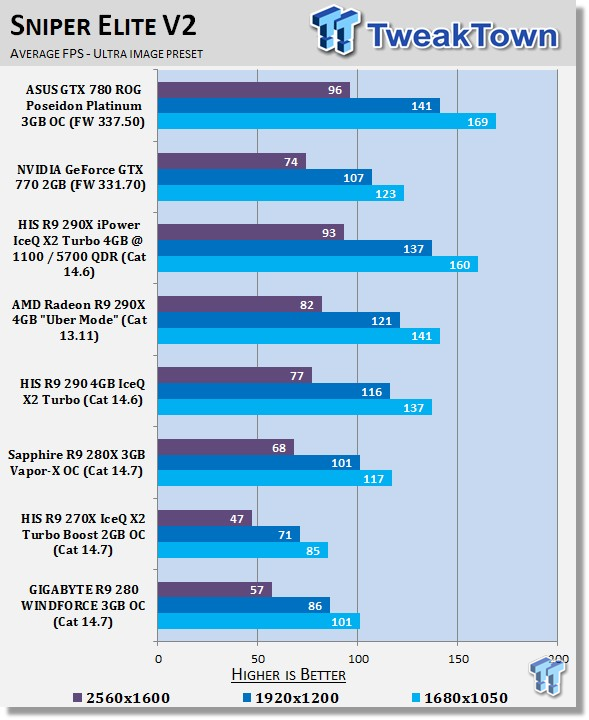
Sniper Elite V2 numbers on the GIGABYTE R9 280 WINDFORCE 3GB OC are good across the board. While we fall short of that 60 FPS average at 2560x1600, you can see that the overall 58 FPS average means only a slight detail drop will be needed to bring the game up to playable levels.
Sleeping Dogs
Version and / or Patch Used: Latest Steam Update


Sleeping Dogs looks great across the board, and you can see that at the highest resolution we manage to score a solid 80 FPS average. Compared to the GTX 770 2GB, you can see that we're pretty much ahead most the time, with the two cards tying up at the highest resolution.
Benchmarks - Hitman Absolution & Tomb Raider
Hitman Absolution
Version and / or Patch Used: Latest Steam Update
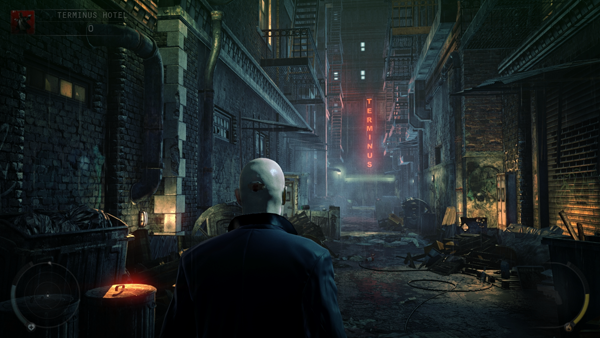

Hitman Absolution sees the GIGABYTE R9 280 WINDFORCE 3GB OC continue to perform well across the board. At the highest resolution, we do see the card fall just short of that 60 FPS average, but considering our minimum is 48 FPS, we'd say the overall playability of the game is great.
You can also see that we manage to come out ahead of the GTX 770 due to the fact it hits that FPS wall quite early.
Tomb Raider
Version and / or Patch Used: Latest Steam Update
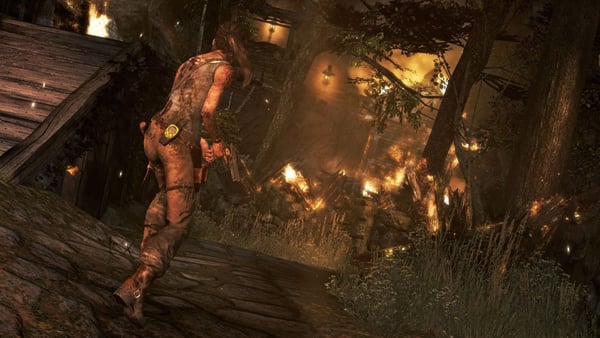

At 1680x1050, we can see that the GIGABYTE R9 280 WINDFORCE 3GB OC puts out a solid minimum and average. Heading north, we can see that the 1920x1200 minimum is strong, but the average falls just a little short of where we'd like it to be. With 1920x1200 being close, 2560x1600 isn't an option.
Benchmarks - BioShock Infinite & Battlefield 4
BioShock Infinite
Version and / or Patch Used: Latest Steam Update
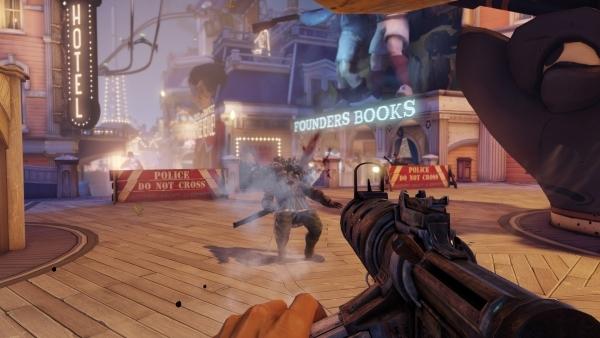

BioShock Infinite sees the GIGABYTE R9 280 WINDFORCE 3GB OC perform very well at 1680x1050. Moving to 1920x1200, the 10 FPS gain it receives over the R9 270X means that we're able to break into the 60 FPS range.
Battlefield 4
Version and / or Patch Used: Latest Origin Update


Looking at Battlefield 4 numbers, you can see that performance is strong across the board, with 1920x1200 and 1680x1050 not being an issue. At 2560x1600, though, you can see that while the minimum is strong, the average is just a little low. Drop detail slightly and bring that average up and you'd have a great gaming experience.
Benchmarks - GRID Autosport
Grid Autosport
Version and / or Patch Used: Latest Steam Update
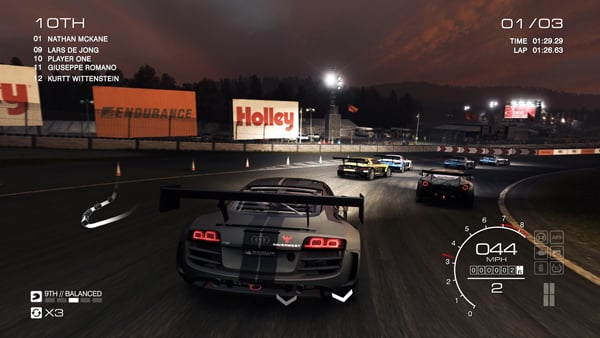

GRID Autosport sees performance that is similar to Battlefield 4. At 1920x1200 and 1680x1050, we can see some great performance.
Moving to 2560x1600, we see a strong minimum but an average that falls shy of where we'd like it to be. Just like we mentioned in BF4, a small detail drop would bring that average up, and you'd end up with a smooth gaming experience.
Benchmarks - High Quality AA and AF
High Quality AA and AF Testing
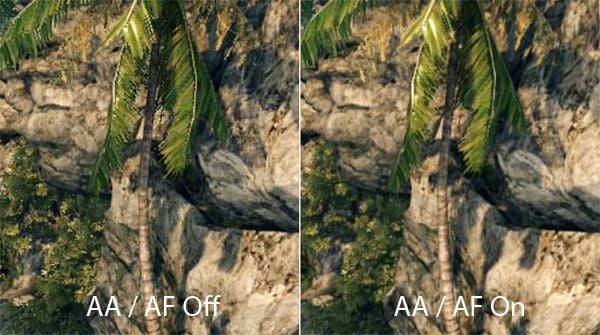
While we test all our games with maximum in-game settings, turning on Anti-Aliasing (AA) and Antistrophic Filtering (AF) helps take the intensity of our testing to another level.
Here we see video cards go from playable FPS to unplayable FPS and the real power houses continue to help break that 60 FPS mark we always aim for to provide a smooth gaming experience.

Turning on AA and AF, it comes as no surprise that Metro Last Light sees the GIGABYTE R9 280 WINDFORCE 3GB OC fall to its knees.

With AA and AF on, we can see that GRID Autosport manages to see the GIGABYTE R9 280 WINDFORCE 3GB OC pull out a playable 64 FPS average at 1920x1200. At 2560x1600, performance is just too low.

Just like Metro Last Light, with AA and AF on, we see these midrange offerings not get the FPS we need at either resolution.
Benchmarks - 4K - 3840x2160 Testing
4K - 3840x2160 Testing

4K monitors are the next step for gamers demanding the best in image quality. With four times the pixels of a standard 1920x1080 monitor (meaning 4x the intensity), 3840x2160 brings with it a new level of intensity to video cards.
Wanting to make sure that you're buying the right video card for a monitor that offers such a large resolution, we test the latest and greatest video cards in a couple of benchmarks to give you an idea of just what kind of setup you require.
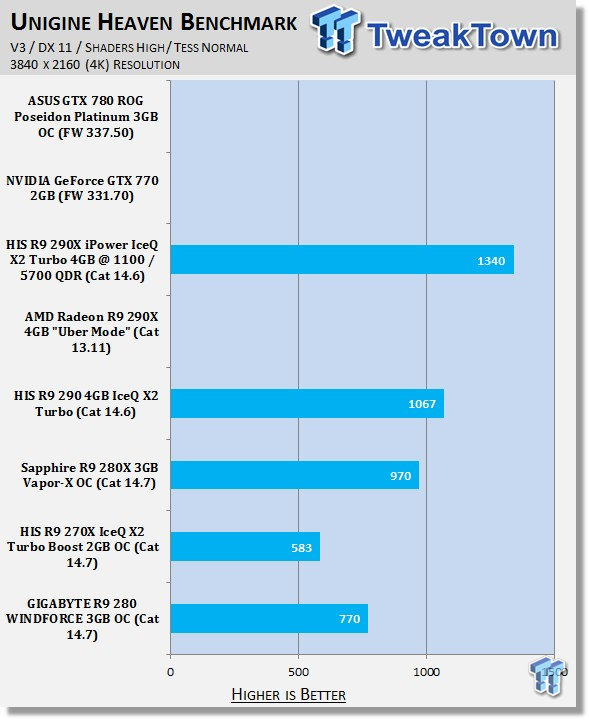
Cranking up the resolution, we can see that the GIGABYTE R9 280 WINDFORCE 3GB OC sits almost perfectly between the R9 270X and R9 280X.

Looking above, you can see that everything but the overclocked R9 290X 4GB falls short of that playable 60 FPS number we need.
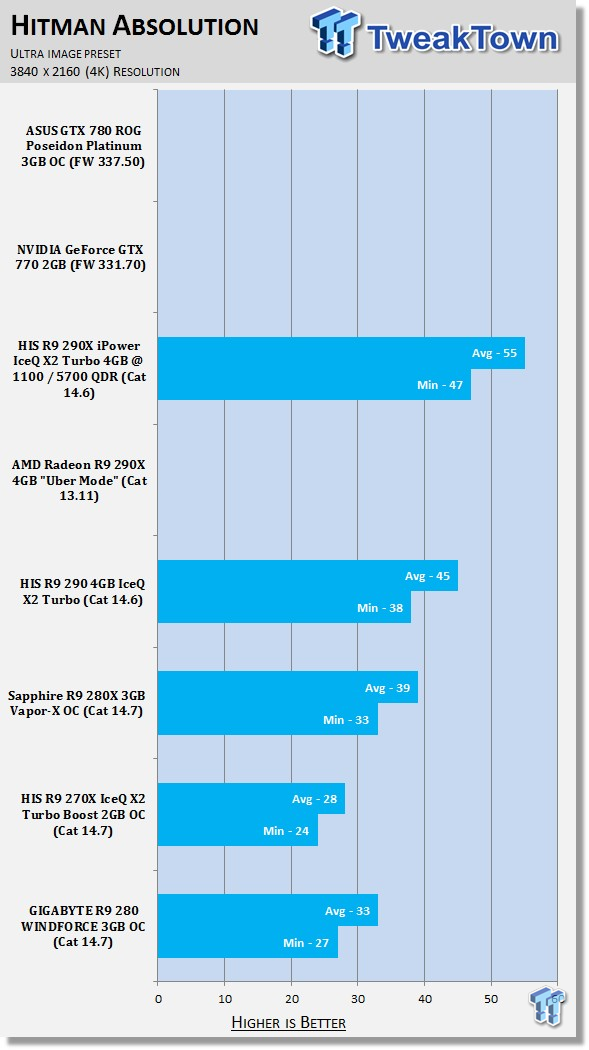
Hitman Absolution performance on all setups here is just too low, with the GIGABYTE R9 280 WINDFORCE 3GB OC having no chance.

Tomb Raider is no doubt one of our more intensive options, and you can see that the FPS just plummet. While we manage to see the GIGABYTE R9 280 WINDFORCE 3GB OC perform well against the R9 270X 2GB, overall performance is just way too low.
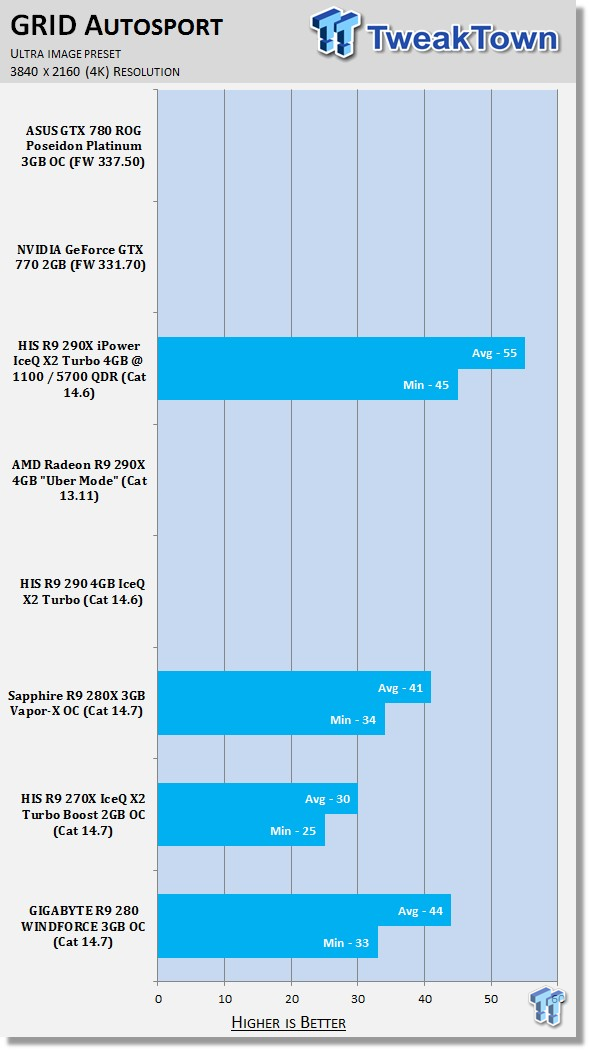
With the resolution right up, we surprisingly see the GIGABYTE R9 280 WINDFORCE 3GB OC get a solid 33 FPS minimum at 4K. Unfortunately, the 44 FPS average is just way too low.
Temperature & Sound Testing
Temperature Test

The temperature of the core is pulled from MSI Afterburner with the max reading used after a completed run of 3DMark Vantage at the Performance preset.

Clearly, the WINDFORCE cooler does a great job, with the core temperature of our GIGABYTE R9 280 WINDFORCE 3GB OC sitting towards the bottom of the pack, exactly where you want to be in a test like this.
Sound Test

Pulling out the TES 1350A Sound Level Meter, we find ourselves quickly yelling into the top of it to see how loud we can be.
After five minutes of that, we get a bit more serious and place the device two CM away from the fan on the card to find the maximum noise level of the card when idle (2D mode) and in load (3D mode).

Noise levels aren't too bad and are sitting towards the middle of the pack. There's no denying that GIGABYTE could've made the card a little quitter if they wanted, and in turn, made it run a little warmer. Overall, though, the numbers from this cooler are strong.
Power Consumption Testing

Using our PROVA Power Analyzer WM-01--or "Power Thingy" as it has quickly become known as to our readers--we are now able to find out what kind of power is being used by our test system and the associated video cards installed. Keep in mind that it tests the complete system (minus LCD monitor, which is plugged directly into AC wall socket).
There are a few important notes to remember, though. While our maximum power is taken in 3DMark06 at the same exact point, we have seen in particular tests the power being drawn as much as 10 percent more. We test at the exact same stage every time, so tests should be very consistent and accurate.
The other thing to remember is that our test system is bare minimum--only an SSD hard drive is used with a single CD ROM and minimal cooling fans.
So, while the system might draw 400 watts in our test system, placing it into your own PC with a number of other items will result in a higher draw.

At the mid 450-watt range during load, you'd want a quality 600-watt power supply to run a setup like this, if not something a little bit higher just to be safe.
Pricing, Availability and Final Thoughts
When we looked at the Sapphire version of the R9 280 3GB, I was not kind to it, and for good reason. At $300, the price of the card was ridiculous. This wasn't Sapphire fault, though. Instead, it was AMD who officially controlled the pricing of models for the most part via the chip pricing to partners. Today, that same card we reviewed can be had in the low $200s or under $200 via rebates from some companies.
This changes the ball game on the model completely and adds a whole new layer of value to the card. It's priced where it should be. You could actually argue that some versions of the R9 280 3GB are a little too low and can be bought cheaper than the R9 270X in some cases. The GIGABYTE version we're looking at today comes in a bit pricier then the Sapphire one we looked at. The overclock on the card, though, is much stronger, and the I/O setup with its dual MiniDP connectors is nicer. That is more of a personal preference from someone who is a heavy user of DisplayPort. Others may prefer the Dual DVI setup that was offered on the Sapphire offering.
Performance of this version of the R9 280 3GB is really strong thanks to the excellent overclock that GIGABYTE is offering us out of the box. It sits well between the two cards on either side of it and doesn't tend to lean too heavily to one side often. The overall balance when it comes to performance is quite strong now thanks to the overclock that GIGABYTE has offered.
When it comes to the bundle, it's all very standard. I again have to mention that the fact that GIGABYTE has chosen to include a DisplayPort to MiniDP connector in the bundle is great. There's nothing worse than getting your brand new card delivered and finding out that you can't plug your DP monitor into it because you don't have a convertor. It's really the small differences that add stronger value to a product.
At the time of writing, there is no way I would take back anything I said about the Sapphire R9 280 3GB. If you went back and looked at that review now and read the conclusion, the information doesn't reflect the card at all now. Unfortunately, this is indeed part of the game. Technology, performance, and all that fun stuff on the model was always fine. The price was just way off.
With the recent price drop, the model now looks a lot more attractive. Overall, it's hard to get too excited about a card that is a rebadge. At the end of it all, though, if you're looking at something around the low $200 mark from AMD, this is a great option, especially this GIGABYTE version with its strong overclock and fantastic cooling setup.
PRICING: You can find the GIGABYTE R9 280 WINDFORCE 3GB OC for sale below. The prices listed are valid at the time of writing but can change at any time. Click the link to see the very latest pricing for the best deal.
United States: The GIGABYTE R9 280 WINDFORCE 3GB OC retails for $232.99 at Amazon.
Canada: The GIGABYTE R9 280 WINDFORCE 3GB OC retails for CDN$368.67 at Amazon Canada.

